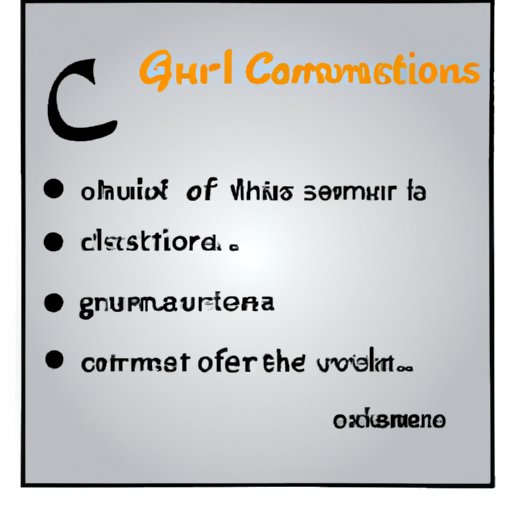Introduction
If you’re like many writers, you may have heard of a semicolon but never fully understood what it is or how to use it. But fear not! The semicolon is a versatile, powerful punctuation mark that can add sophistication and clarity to your writing. In this article, we’ll explore everything you need to know about using semicolons, from the basics to advanced techniques.
Master the Subtle Art of Punctuation: A Beginner’s Guide to Semicolons
Let’s start with the basics. A semicolon is a punctuation mark that is used to separate two independent clauses that are related in meaning. Unlike a period, which would create two separate sentences, a semicolon allows you to connect the ideas more closely. For example: “I have always loved science; it’s a fascinating subject.” In this case, the two clauses could each stand alone as complete sentences, but the semicolon emphasizes the relationship between them.
Semicolons can also be used instead of a comma to separate items in a list when the items are themselves phrases or clauses that already contain commas. For example: “The dinner menu included steak, cooked medium-rare; roasted potatoes, seasoned with garlic and rosemary; and green beans, lightly steamed.”
Semicolons Made Simple: Tips and Tricks for Using the Tricky Punctuation Mark
Some people find semicolons confusing or intimidating, but once you understand their proper use, they become much easier to incorporate into your writing. One common mistake people make is using a semicolon to separate an independent clause from a dependent clause; that is, a clause that cannot stand alone as a sentence. For example: “After I finish my work; I plan to go for a run.” In this case, the second clause is dependent and should be connected to the first with a comma, not a semicolon.
Another common mistake is using semicolons too frequently or haphazardly, which can make your writing seem stilted or cumbersome. Rather than trying to use semicolons in every sentence, focus on situations where they will add clarity or emphasis, such as when you want to show the relationship between two ideas.
Punctuate Like a Pro: Understanding the Right Place to Use Semicolons
To truly master semicolons, it’s important to understand the different types of sentence structures that are appropriate for their use. One key factor is whether the two independent clauses are closely related in meaning; if they are too dissimilar, a semicolon may not be the best choice. For example, “I love playing guitar; my sister is an excellent artist” might benefit from a period instead to emphasize the contrast between the two ideas.
Semicolons can also be used to connect longer, more complex sentences that might otherwise be difficult to follow. For example: “Despite the rain, which had been falling nonstop for hours, the children decided to go outside and play; they were determined to make the most of their vacation.” This use of a semicolon emphasizes the contrast between the weather and the children’s determination, while also keeping the related thoughts together in one sentence.
The Dos and Don’ts of Using Semicolons Effectively in Academic Writing
As you may have guessed, semicolons can be particularly useful in academic writing, where complex sentence structures and formal language are common. However, it’s important to use them correctly and appropriately to avoid common errors. One common mistake is using a semicolon to connect a dependent clause to an independent clause, which can create a grammatically incorrect sentence.
Another mistake is using semicolons too frequently or in situations that aren’t truly appropriate. Rather than trying to impress your instructor with tons of semicolons, focus on using them selectively to emphasize the relationships between ideas. For example, you might use a semicolon to connect two pieces of evidence in a research paper, or to emphasize the contrast between two arguments.
Revamp Your Writing with the Power of Semicolons: A Comprehensive Guide to Becoming a Polished Writer
If you’re ready to take your writing to the next level, incorporating semicolons is a great place to start. Not only do they add sophistication and clarity, but they also give you more control over your sentence structures. Some tips for incorporating semicolons into your writing include:
- Practice identifying situations where a semicolon would be appropriate
- Read examples of well-written sentences that use semicolons effectively
- Experiment with different types of sentence structures and see where a semicolon might fit in
- Ask a writing tutor or friend to review your work and provide feedback on your use of semicolons
Conclusion
By now, you should have a good understanding of what semicolons are, how to use them effectively, and why they can add value to your writing. Remember, like any punctuation mark, semicolons should be used selectively and appropriately to enhance your meaning and make your writing more polished and sophisticated.
